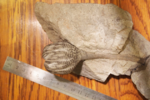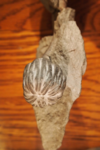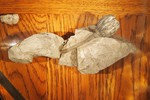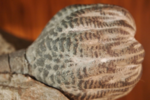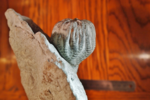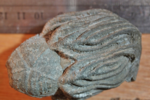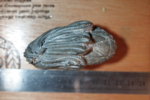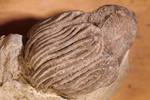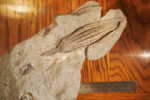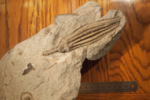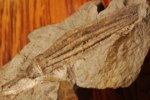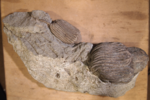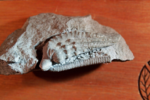
Crawfordsville Crinoid Photo Gallery
These Lower Mississippian age crinoids of Indiana were mined from a crinoid lens discovered within a ravine leading into Indian Creek during the early 1980s. The geologic unit from which they were obtained is called the Ramp Creek member of the Edwardsville formation. The crinoid deposit is characterized by being contained within an unusually thick homogenous bed of siltstone measuring two feet in thickness. The crinoids were contained within the bottom six to eight inches of the bed, which also featured graded bedding, such that the upper portion of the layer was finer grained and devoid of fossils. I interpreted it to be an instantaneous deposit in which the crinoids were buried alive with their associated fauna. Among the contemporaneous fossils are intact platycerid gastropods and starfish associations. Infrequent brachiopods were present along with large fragments of glass sponges and frequent pieces of fenestrate bryozoans. Half of a large elongate bivalve mollusc was found and also an intact conularid and compressed nautilus shell that is also mostly intact.
Although many of the crinoids had stems attached to the crowns many crowns were also found to be detached from their stems. The difficulty encountered with excavating and retrieving the slabs from this layer limited the number of crinoids that could be retrieved with their stems intact unfortunately. The deposit became informally known as the "blue lens" because I had found a brown lens of crinoids the previous day during a weekend excursion doing reconnaisance. I found these deposits at Indian Creek after searching several known localities outside of this area with a friend one weekend, and then eventually we decided to explore a portion of Indian Creek that had no reported localities on the following weekend. I was aided by a recently published monograph on Crawfordsville crinoids done by Dr. N. Gary Lane of Indiana University which I had read thoroughly, and by the advice I had been given by a student of his, namely to search the ravines leading into the creeks to find the crinoids.
Indian Creek was a locality that I felt certainly would have undiscovered crinoid deposits because the investigator of that area during the 1800s had died at an early age and therefore it was unlikely that he could have explored the area very completely. This proved to be correct but early on I was to find that others were hunting this area as well. The brown lens that I had found the day before on a Saturday became the asset of a local crinoid specialist. I was not welcome there after that So I felt very fortunate to be able to work the blue lens which I had found the following Sunday without competition from any other fossil hunters. As I was a student at the time I offered to clean and donate specimens from this deposit to the university that I was attending while completing a Masters thesis concerning the paleoecology of Ordovician Cincinnatian molloscs. My offer was rejected though by the equipment manager who controlled the use of the university's air abrasive machine within the prep lab. Although my thesis advisor welcomed the idea this inconvenience prevented me from donationing specimens to them. Nevertheless, I did keep working this deposit and retrieving crinoids over the next two years, even after graduation and moving to Oklahoma.
The crinoids were collected during day long excursions normally with the aid of a helper, along with the use of a large portable Stihl rock saw, shovels,picks, a rock hammer, two 6 foot pry bars, a 16 and 18 lb sledge hammer, a tempered jackhammer drill bit, and of course, 2 wedges. After a long day of mining a small portion of the deposit was "sawed" out and excavated using the prybars and drill bits and sledges. It was always necessary to saw off the upper portion of the two foot thick silstone in order for the bottom portion to be wedged out in lengths along the face of the exposure. Horizontal cuts were made into the siltstone across the length of the bed at 6 inch or less intervals and then vertical cuts were made at similar intervals to create partitions that could be extracted using a chisel or wedge and a hand sledge. This was done to remove roughly 16 inches off the top of the layer down to where the crinoids were within the lower 6 to 8 inches. That remaining portion of the bed was excavated afterward by using the 6 foot pry bars after the wedges had been driven beneath the bed. The slabs and pieces that were removed during the day were then carried to the car at day's end. Normally it would take about three hours or more of driving each way to and from the locality from where I was living in Ohio, so collecting days were long. Many return visits were made over the next years, most occurring after my relocation to Oklahoma where I had become employed within the petroleum industry. I last visited and worked this locality during the mid 1990s and then I made a trip to this area in 2016. At that time I learned that the property owners who used to allow me access had sold their land to the Indiana State Park System. Perhaps one day I will be able to show someone from the Parks department where the site is. The deposit had a width of about 25 feet and the center of the deposit was still producing but had become more inaccessible due to the overburden of the creek bank.
This portion of a large slab contains two Agaricocrinus splendens crinoid crowns along with the crinoid Pachylocrinus aequalis and the crinoid Abrotocrinus unicus and is only partially prepared. This is the bottom of the layer but the last two pictures are of the bottom overturned. This piece fits to a much larger slab that it was broken off of. It was mined during the month of August in 1982.
This is the same slab after additional preparation in late 2020.
This is the crinoid Taxocrinus colletti that was collected early within the mining of the deposit. The crown was exposed approximately eight inches from the bottom of the layer and excavated as a piece with only a portion of the stem unfortunately. Few of this genus of crinoid were recovered from the deposit, one other being less than half this size and two others as small juveniles. Taxocinus is reported to be rare within the Indian Creek fauna and this deposit is no exception. The crown of this crinoid has only been cleaned with the clip end of a Bic ink pen plastic cap. Only the stem has been cleaned using an air abrasive.
The three crinoid crowns featured below are Platycrinites saffordi. This species was generally represented by large sized individuals. The crinoid was normally found without the stem attached though, while long lengths of stems were found separately missing their crowns. Invariably a platycerid gastropod would be attached to one side of the crinoid crowns.
These are two Gilbertsocrinus tuberosus crinoid crowns Both of these crowns are missing their stems but a couple others were found with their stems attached.
Below is a large Scytalocrinus robustum crinoid crown that features a broken and regenerated arm. The other crinoids shown are Cyathocrinites multibrachiatus, Macrocrinus mundulus, and Halysiocrinus nodosus.
This is a large slab containing the crinoids Agaricocrinus splendens and Onychocrinus ulrichi, along with a partial Onychaster flexilis starfish.
This crinoid slab contains a complete crinoid Cyathocrinites multicrachiatus. The distal end of the stem is reduced in width and bifurcated, and apparently was not attached to the substrate. Therefore, it was a free swimming crinoid.
This small piece contains the crinoid Macrocrinus mundulus with a portion of its' stem.
This small piece had an unusual crinoid along with Macrocrinus mundulus.
This is a small slab with some of the several different crinoids within it shown and described.
This is a piece of the brown lens showing an Onychocrinus ulrichi crown and a few other smaller crinoids.
I plan to add more photos in the future as there are more of these crinoids that I have not photographed yet for exhibiting here. And I still continue to work on these pieces when I am able to get the time and then sometimes more crinoids are found within the rocks. In many cases they are the gift that keeps on giving.
